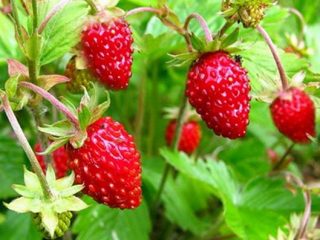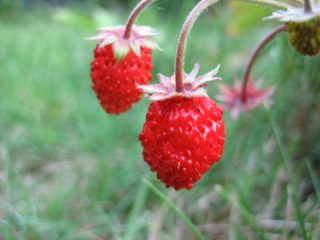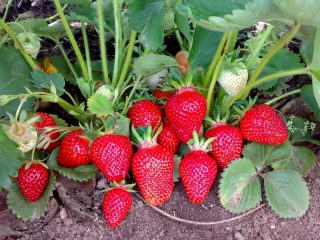Content
Alpine strawberries in the wild are famous for their excellent taste and aroma. Breeders crossed the plant with other forms and obtained an excellent remontant variety, Ruyan. The culture immediately became popular among gardeners due to its ease of care, since the bushes do not form mustaches. Ruyan strawberries are easily propagated by seeds, are unpretentious in care, and are rarely affected by diseases.
Breeding history
A remontant crop was bred by Czech breeders. The variety was brought to the territory of the Russian Federation in the nineties. Ruyana's parents are wild forms of alpine strawberries. Breeders managed to preserve the original aroma of wild berries. To date, the remontant variety Ruyana has spread throughout Ukraine and Belarus.
Description
Remontant strawberry bushes grow compact with densely crowded foliage.The crown of Ruyana forms a ball shape. The maximum height of the bush is 20 cm. A feature of the remontant variety Ruyana is the high arrangement of peduncles, which is unusual for strawberries. Flowers on high stalks protrude above the foliage level. Gardeners called this feature a plus. The berries always remain clean after rain or watering, since the foliage covers them from below the ground.
The fruits grow conical in shape. Occasionally, distorted berries are found. The maintainability of the variety already indicates that the fruits are large. The diameter of the berry reaches 1.5 cm. The fruit weighs about 7 g. The ripe berry acquires a bright red color. Small grains are located in deep depressions on the skin of the fruit. The inside of the berry is pink. The pulp is not loose, juicy, rich in forest aroma. Due to their high density, the fruits of remontant Ruyana do not crush during harvesting, transportation and storage.
Young bushes of the remontant strawberry Ruyan begin to bear fruit from the second year after planting in the garden. The stage of rapid flowering occurs in May. The first wave of the crop is harvested in June. Ruyana bushes bloom continuously in warm areas until the third ten days of November. In cold regions, flowering lasts until October. The big advantage of the remontant strawberry variety is its high yield. From 1 m2 the beds harvest about 2.5 kg of fruit.
Advantages and disadvantages of the variety
An overview of the positive and negative qualities of remontant strawberries Ruyan helps the gardener become more familiar with the variety. For convenience, all parameters are included in the table.
| Advantages | Flaws |
| Long fruiting until cold weather | Grows well only in light soil |
| Tall flower stalks are not contaminated by soil | Fruits become smaller due to lack of moisture |
| No mustache | Bushes need to be renewed every 4 years |
| Variety resistance to fungal diseases | |
| Berries are well stored and transported | |
| Mature bushes are able to winter without shelter | |
| Strawberries easily survive drought |
Methods of propagation of beardless remontant strawberries
The easiest way to propagate wild strawberries and strawberries is by means of tendrils. Since the remontant variety Ruyana is deprived of this possibility, there are two ways left: dividing the bush or seeds.
Dividing the bush
If the remontant Ruyan strawberry is already growing in the yard, then it is easier to propagate it by dividing the bush. The procedure is performed in the spring before flowering begins or in the third ten days of August. For better survival of seedlings of the Ruyany variety, work is carried out on a cloudy day. An adult plant is divided into 2–3 parts so that each specimen has a full root and at least 3 leaves.
The separated parts of remontant strawberries are planted at the same depth as the entire bush grew before. The seedlings are watered abundantly and shaded from the sun. When the divided Ruyan strawberries take root, the shelter is removed.
Growing Ruyana from seeds
You can grow seedlings of remontant Ruyan strawberries from seeds in any container. Boxes, flower pots, and plastic glasses are suitable.
The video shows the technology for growing strawberries from seeds:
Seed production technique and stratification
It is better to buy remontant strawberry seeds in the store. If the Ruyana variety is already growing at home, then the grains can be collected from the berries yourself.Large, slightly overripe strawberries without visible damage are selected from the garden bed. Using a sharp knife, cut off the skin of the berry along with the grains. The prepared mass is spread out on glass or a flat plate and placed in the sun. After 4–5 days, the remaining pulp will be completely dry. Only strawberry seeds will remain on the smooth surface. The grains are packed into bags and sent for storage in a cool place.
Before sowing, the seeds of the remontant strawberry Ruyan are subjected to stratification. The procedure involves hardening the grains with cold. Gardeners usually use two methods of stratification:
- Place a thin layer of cotton wool in a regular plastic bag and moisten it with water from a spray bottle. The seeds of Ruyan's remontant strawberry are laid on top of a cotton cloth. The bag is tied and placed in the refrigerator for three days. After stratification is completed, cooled seeds are immediately sown in warm soil.
- The fertile soil is calcined in the oven, cooled to room temperature and scattered on a tray. A layer of snow 1 cm thick is poured on top. You will need tweezers to lay out small grains. Each seed of the Ruyan remontant strawberry is placed on the snow, keeping an interval of 1 cm between them. The tray is covered with a transparent film and placed in the refrigerator for three days. After this time, the crops are taken out and placed in a warm room. The film is removed only after germination.
In nature, strawberries grow when the snow melts. Such conditions are more familiar to her, therefore, to stratify seeds of the remontant variety Ruyana, it is better to choose the second method.
Sowing time
Ruyan's remontant strawberry seeds begin to be sown from early March to mid-April. In warm regions, sowing time is shifted to the end of February.Ruyan seedlings must be provided with artificial lighting, since daylight hours are still short at this time of year.
Sowing in peat tablets
Sowing Ruyana grains in peat tablets can be combined with stratification:
- Peat washers are placed in a plastic container. Pour in melted or settled water, where a pinch of the drug Fitosporin is first dissolved. After the peat discs swell, the planting nests are filled with soil.
- The peat tablets are covered with a layer of snow 1–2 cm thick on top.
- The grains of Ruyan's remontant strawberries are laid out on top of the snow.
- The container with the crops is covered with a transparent film and sent to the refrigerator. The snow will gradually melt and the grains themselves will sink into the soil of the washer's landing nest to the required depth.
- After 2–3 days, remove the container from the refrigerator and place it in a warm room. The film is removed after germination.
- Some of Ruyana’s grains will definitely grow past the peat tablet’s planting nest. Seedlings can simply be removed or replanted after three leaves appear. Each tablet should contain one fathom of remontant Ruyan strawberry.
Before planting, seedlings of the remontant variety are hardened and taken outside.
Sowing in the soil
You can sow Ruyana seeds in the ground in a similar way, combining with stratification. If the grains have already been hardened by cold, then proceed immediately to sowing. Soil is collected from the garden or bought at the store. Any container is used for sowing.
Interesting way growing remontant strawberry seedlings Gardeners invented Ruyan in snails.Take a tape 1 m long and 10 cm wide. Foamed polyethylene or a laminate backing is suitable. The material must be flexible. Moist soil 1 cm thick is laid out on top of the tape. Stepping back 2.5 cm from the side edge, Ruyan strawberry seeds are laid out on the ground in 2 cm increments.
When the entire section of the tape is sown with grains, it is rolled up. The finished snail is placed in a deep plastic container with the crops facing up. Rolls are made exactly as much as is needed to completely fill the container. A little melt water is poured into the container, the snails are covered with film and placed on the windowsill for germination.
Picking sprouts
Picking seedlings of remontant strawberries Ruyan is carried out after the growth of 3-4 full-fledged leaves. The most acceptable and gentle method is called transshipment. Using a small spatula or an ordinary spoon, dig up a remontant strawberry seedling along with a lump of soil. In this state, it is transferred to another seat, for example, a glass. After picking, the root collar of the seedling is not immediately covered with earth. Only after the Ruyanya strawberries have taken root, soil is added to the cup.
Why don't the seeds germinate?
The problem of poor germination of Ruyan remontant strawberry seeds is their poor preparation. Often inexperienced gardeners ignore stratification. Sometimes the problem lies in the poor quality of the grains themselves, collected with one’s own hands from remontant strawberries. If the first crop does not germinate, the procedure is repeated. However, it is advisable to take new soil or disinfect it along with the planting containers, since the crops may have been destroyed by a fungus.
Landing
When it gets warm outside and the seedlings grow, we begin planting the remontant Ruyan strawberries in the garden bed.
How to choose seedlings
Further productivity depends on good seedlings of remontant strawberries. Seedlings are selected with bright green, intact foliage. There should be at least three of them. Ruyana seedlings are suitable only with a horn thickness of at least 7 mm. The length of the exposed roots should be at least 7 cm. If the seedling was grown in a peat tablet or cup, a good root system will be braided throughout the whole room.
Site selection and soil preparation
Beds for remontant strawberry variety Ruyans are placed in a sunny place. Light shading by trees is allowed. The soil is dug up with compost at the rate of 1 bucket of organic matter per 1 m2. For looseness, you can add sand. If the area has high acidity, add ash or chalk when digging.
Planting scheme
For remontant strawberries of the Ruyana variety, planting in rows is preferable. A distance of 20 cm is maintained between each bush. The row spacing is about 35 cm. The strawberry variety Ruyana is beardless, so the plants can even be planted in one row near a bed with other garden crops.
Care
The procedure for caring for remontant strawberries Ruyan is the same as for other varieties of strawberries.
Care in spring
In the spring, after the snow melts, the beds are tidied up. Remove old foliage and loosen row spacing. Watering is carried out with warm water, adding 1 g of copper sulfate or the same amount of potassium permanganate to 1 bucket. With the appearance of the ovary, the strawberries are watered with a solution of boric acid at the rate of 5 g of powder per 10 liters of water.
Spring fertilizing is carried out with mineral nitrogen-containing fertilizers.Strawberries respond well to fertilizing with liquid organic matter: a solution of mullein 10 or bird droppings 1:20. During flowering, Ruyana is fertilized with potassium-phosphorus preparations.
Watering and mulching
Remontant Ruyana easily tolerates drought, but the quality of the berries deteriorates. In dry summers, the strawberry plantation is watered daily, especially when the berries begin to set. For watering, choose the evening, preferably after sunset.
To retain moisture and get rid of weed the ground around the bushes is mulched with sawdust and small straw. Gardeners practice covering the beds with black agrofibre as mulch, and cut windows for remontant strawberry bushes.
Fertilizing
Strawberries of the Ruyana variety begin to be fed from the second year of life. The first fertilizing with ammonium nitrate (40 g per 10 liters of water) is carried out in early spring before the formation of flower buds. The second fertilizing with nitroammophoska (1 tablespoon per 10 liters of water) is performed when buds form. The third feeding (2 tbsp. nitroammophoska, 1 tbsp. potassium sulfate per 10 liters of water) is performed during fruit set. Ruyana strawberries respond well to fertilizing with biological products presented in the table.
Frost protection
During flowering, remontant strawberries are afraid of short-term frosts. Greenhouse shelters made of agrofibre help protect plantings. You can also use ordinary transparent film.
Diseases and control methods
The remontant alpine variety is resistant to diseases, but during an epidemic they can appear. The most dangerous diseases and control methods are presented in the table.
Pests and ways to combat them
Pests are not averse to eating the sweet berries of Ruyana's strawberries. How to deal with them is shown in the table.
Harvest and storage
Strawberries are harvested regularly every 2-3 days. The best time is early morning after the dew has disappeared. The berries are picked from the stem and placed in a small but wide container. Berries can be stored in the refrigerator for about a week. For long-term storage, the fruits are frozen.
Features of growing in pots
If desired, a remontant Ruyana can be grown in a room. Any flower pot with a depth of 15 cm will do. Caring for the plant is the same as outside. In winter, you only need to organize artificial lighting. During flowering, artificial pollination is done with a brush with soft bristles. With the onset of summer, pots with Ruyana are placed on the balcony.
Bottom line
Any gardener can grow the remontant variety Ruyan. A garden bed with beautiful bushes will decorate any yard.




























Excellent berry, germination rate 100%!
For the first time I decided to start sowing seeds, and everything worked out.
The bushes are in their second year.
It bore fruit very abundantly in the first year even before the snow.
pleases the eye
The wonderful variety Ruyana began to bear fruit in the first year until the end of October, I live in Transbaikalia.